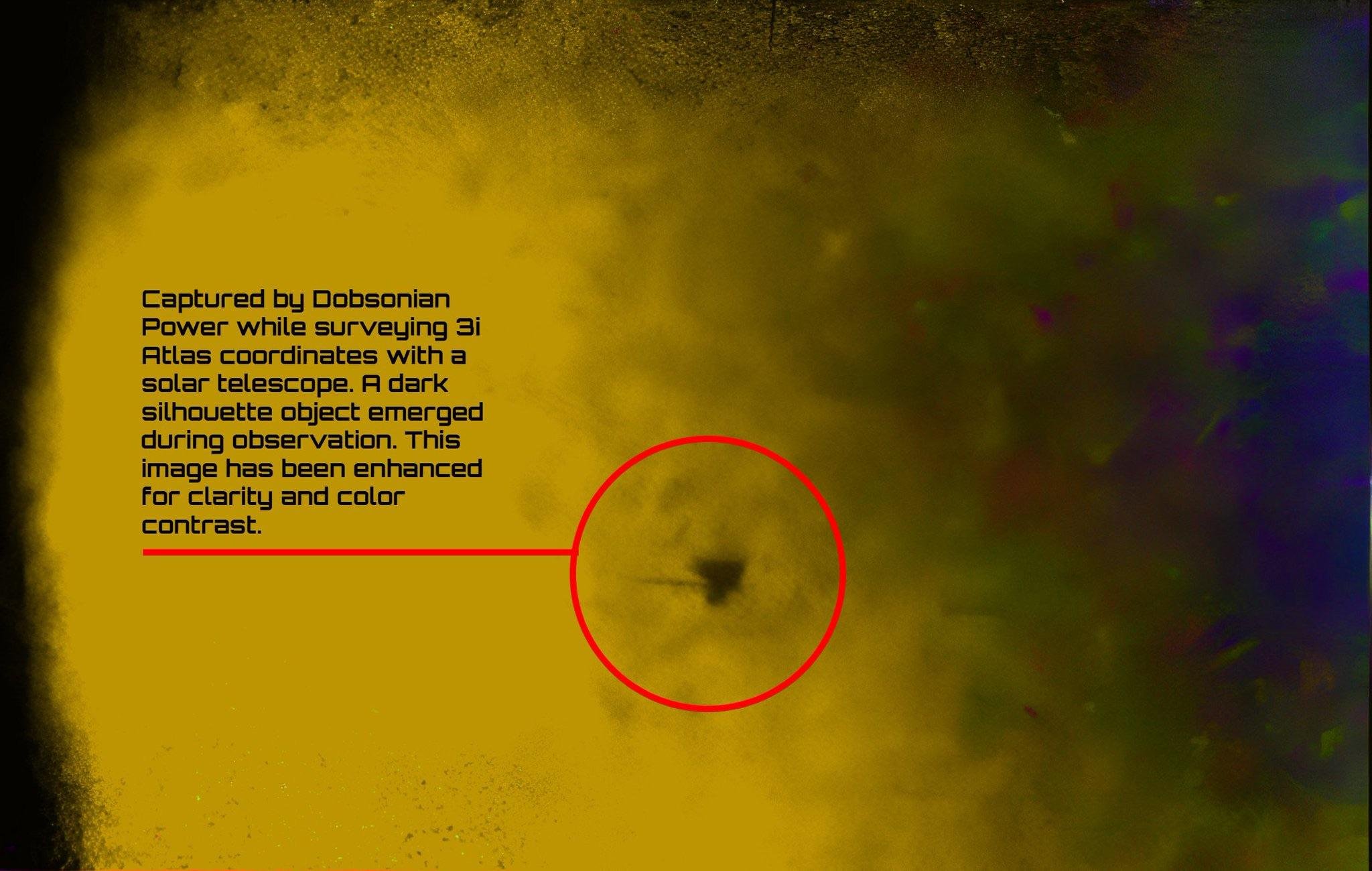The Viral Image That Broke the Internet
Today is October 3rd, 2025, the day we've been counting down to for months: 3I/ATLAS's historic Mars flyby. And right on cue, a dramatically enhanced telescope image hit social media with the breathless caption: "What on Earth is it?"
The image, captured by YouTuber Dobsonian Power using a solar telescope and heavily processed with digital enhancement, shows what appears to be an unusual dark structure within 3I/ATLAS. Within hours, the speculation exploded: alien spacecraft, technological components, structural anomalies. AI-generated images of sleek metallic probes began flooding social media, each more elaborate than the last.

But here's the problem: this viral moment is a perfect example of how the wrong equipment, image processing artifacts, and timing can create a mystery where none exists.
Critical Context: This image was captured using solar observation equipment, heavily digitally enhanced, and shared on the exact day of maximum public interest in 3I/ATLAS. Let's separate the facts from the fiction.
Why This Equipment Can't Show You What You Think It Shows
Dobsonian telescopes, while excellent for certain types of astronomy, are not designed for capturing detailed images of faint, distant comets. Solar telescopes, specifically, are optimized for observing the Sun's surface, not deep space objects traveling at interstellar velocities.
Here's why this matters:
Key Points
- Solar telescopes use specialized filters designed for extreme solar brightness, not faint comet imaging
- Dobsonian mounts lack the precise tracking needed for long exposures of fast moving objects
- Digital enhancement amplifies not just real features but also noise, atmospheric distortion, and optical aberrations
- The "structure" visible could easily be image artifacts, atmospheric turbulence, or processing errors
Professional observatories use entirely different equipment for comet imaging: telescopes with precise tracking systems, optimized for deep space observation, with carefully calibrated cameras and minimal digital processing. The Webb Space Telescope, SPHEREx, and other instruments studying 3I/ATLAS use fundamentally different approaches that eliminate these artifacts.
The dark feature circled in red? Most likely a combination of uneven dust distribution in the coma, atmospheric seeing conditions, optical aberrations from using solar equipment for the wrong purpose, and aggressive digital enhancement that amplified noise into apparent structure.
The Timing Isn't Coincidental
Today, October 3rd, 2025, marks 3I/ATLAS's closest approach to Mars. We've been building toward this moment for weeks, with legitimate scientific anticipation about what NASA's Mars Reconnaissance Orbiter might reveal. Professional astronomers worldwide are analyzing data from state of the art instruments.
And suddenly, on this exact day, a heavily processed amateur image goes viral with mysterious implications.
This isn't to suggest any intentional deception, but the pattern is clear: major astronomical events attract attention, and that attention can amplify images that appear dramatic but lack scientific rigor. When legitimate mysteries exist (and 3I/ATLAS does present real scientific puzzles about its composition and origin), it becomes even easier for artifacts and processing errors to be misinterpreted as evidence of something extraordinary.
The Real Mystery: 3I/ATLAS does show genuinely unusual characteristics, including exotic nickel emissions and unexpected chemical signatures. These are documented by professional observatories and published in peer reviewed research. We don't need blurry amateur images to make this object interesting.
The flood of AI generated images showing sleek spacecraft or technological structures reveals more about our hopes and imagination than about 3I/ATLAS itself. These renderings are creative fiction, not evidence.
What We Actually Know About 3I/ATLAS Today
Rather than speculating based on a single amateur image captured with inappropriate equipment, let's focus on what professional observations are actually telling us:
NASA's Mars Reconnaissance Orbiter is currently attempting observations with its HiRISE camera, potentially providing the first detailed images of an interstellar object from a planetary spacecraft. These images, if successful, will have scientific calibration, peer review, and genuine resolution capable of revealing actual structural features.
Ground based professional observatories continue monitoring 3I/ATLAS with proper deep space imaging equipment, tracking its activity, composition, and behavior as it makes this historic flyby.
The real story of 3I/ATLAS doesn't need embellishment. Its genuine mysteries (exotic chemistry, unusual composition, interstellar origin) are fascinating enough without misidentifying image artifacts as alien technology.
Bottom Line: The viral telescope image shows us the limitations of amateur equipment and the dangers of over-interpretation, not hidden structures in 3I/ATLAS. Wait for the professional observations from Mars orbit, those will be the images that actually matter.
When extraordinary images from NASA's Mars observations become available, we'll cover them here with proper context and analysis. Until then, let's appreciate 3I/ATLAS for what it actually is: a genuinely mysterious interstellar visitor that deserves serious scientific study, not social media speculation.
